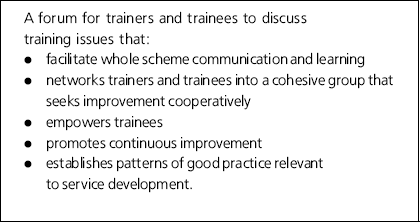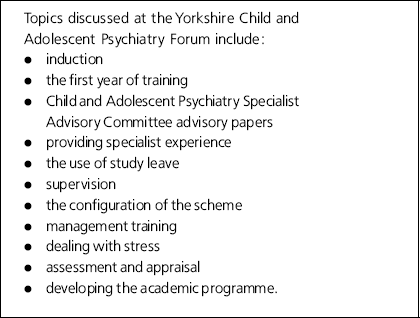The Royal College of Psychiatrists' Higher Specialist Training Handbook (1998) emphasises the need for training schemes to be well organised in order to provide an environment in which training needs can be met. Training programme directors are tasked to provide “regular meetings with the trainees as a group to discuss the scheme and its placements” as well as “occasional meetings with trainers to discuss the scheme and its further development”.
The Yorkshire Specialist Registrar Training Programme for Child and Adolescent Psychiatry has established a joint forum for trainers and trainees, aimed at improving the organisation and quality of training across the scheme. This approach has been found to have a number of advantages and could be beneficial to other schemes of training.
The need
With the arrival of Calman training (Department of Health, 1993) and clear and specific educational objectives (Child and Adolescent Psychiatry Specialist Advisory Committee [CAPSAC], 1999) the demands on training have increased while the length of training reduced. This provides the potential for conflict between the competing needs of learning and clinical roles (Reference Eminson and GreenEminson & Green, 1997). Despite clear guidelines, trainees are not universally and consistently receiving the training experiences expected and the clearer dissemination of information on available training experiences has been identified as important (Reference Smart and CottrellSmart & Cottrell, 2000).
The rapid expansion of the Yorkshire Specialist Registrar Training Scheme in Child and Adolescent Psychiatry in the mid 90s and requisite need for developments across the scheme, necessitated a structure where training issues could be addressed in a more systematic way. Although the Yorkshire Psychiatry Specialty Training Committee Subgroup for Specialist Registrar Training in Child and Adolescent Psychiatry had overall responsibility for provision of training, there was no process for regular consultation and involvement of all trainers and trainees.
In 1995 and with the support of CAPSAC, the scheme established a Joint Trainers and Trainees Forum. This new networking forum aimed to establish a trainer/trainee interface, to jointly review and adapt training over time (Box 1). This would ensure that established and new trainers and trainees were up to date with current training requirements.
Box 1. Aims of the forum

| A forum for trainers and trainees to discuss training issues that: |
|
The response
The Forum takes place three afternoons a year, with all scheme trainers and trainees invited to attend. Holding the forum on the same half-day as the academic programme has facilitated attendance; the term is extended to avoid a reduction in the academic content of training. A workshop format places an emphasis on small group discussion and feedback. Groups are configured to encourage specialist registrars (SpRs) and consultant trainers to analyse issues together and consider options that would improve the overall effectiveness of the scheme. At the same time the sessions aim to be educative and informative. These meetings address common training themes (Box 2) and are not a forum to address complaints or concerns about individual trainers or trainees. Such issues are appropriately dealt with elsewhere.
Box 2. Forum topics

| Topics discussed at the Yorkshire Child and Adolescent Psychiatry Forum include: |
|
Each forum is facilitated jointly by a trainer and trainee with a special interest in the topic for discussion. Trainees are encouraged to organise one of the meetings a year without trainer involvement, thus ensuring that the trainees have the opportunity to set the agenda independently and to challenge the organisation of training in a constructive way. Workshop discussions are subsequently written up in summary form and circulated.
The outcomes
Although the forum does not carry decision-making responsibility, the group has been highly effective in influencing positive change. Recommendations have informed discussion and outcomes at the training subgroup.
Some developments across the scheme have been consequent upon sharing areas of good practice at the trainers and trainees forum. This has led to the raising of standards across all placements. Following the meeting exploring good practice in induction, a new scheme policy was introduced: in each placement there is now a requirement for a local induction providing an organised programme supported by written information appropriate to the needs of a SpR. An induction folder for the whole scheme has been developed by the training subgroup and is now available to all newly appointed trainees.
On occasions the training subgroup has found it useful to seek direction from the forum; an example of this relates to emerging concerns about the size of the scheme. With increasing numbers of trainers and trainees, there was a proposal that the scheme should split into two. The forum was able to openly discuss the advantages and disadvantages of such a course, resulting in a clear consensus that the scheme should remain one. The collaborative process allowed for the trainee perspective to be fully integrated into the discussion.
Formal recognition of the increasing size and complexity of the scheme (but the need to keep it as one) did, however, lend support for the development of ‘sub-tutors’. These trainers now assist the programme director by sharing the workload of the annual visits to placements. The scheme now has 17 national training numbers and three sub-tutors.
A challenge for any training scheme is to ensure that required learning opportunities and experiences are available to each of the trainees during their 3 years and that educational input is up to date and relevant. Through forum discussion it became clear that the programme director would need support if all the more specialised areas of training outlined by CAPSAC were to be addressed in detail.
In response the scheme developed the concept of ‘lead roles’, where one trainer overviews the availability and promotes the provision of training within a specialist area across the scheme. These trainers feed back to the committee and are points of contact for trainers and trainees alike. This is a model of good practice adopted by CAPSAC (CAPSAC, 1999) as a recommended approach in managing larger schemes. There are five trainers with a lead responsibility for areas of training including learning disability, paediatric liaison, forensic psychiatry, the psychotherapies and management. Since their inception, several whole scheme surveys have been conducted.
As well as the aims outlined above it has become apparent that the forum provides other important functions.
Trainers are kept abreast of new requirements of them as educational supervisors; assessment and appraisal, supervision and the new advisory papers being good examples. Trainees are similarly kept informed of what they can expect and even demand of their trainer. It is likely that this approach supports compliance to training standards across the scheme.
Trainees develop early insights into the difficulties and demands of providing quality training. A year after appointment as a consultant, many will become trainers themselves. By exposing trainees to issues from both perspectives, the sessions gain added value as an early opportunity to train the trainers.
Trainees experience a consultation forum in which their views as consumers of a service are valued and influential. As trainees contribute to the shape of training in Yorkshire, it is hoped that they will later, as consultants, understand the benefits of similarly consulting with their own service users.
Finally, the sessions are great fun; a time-out to reflect but also to chat and catch up on news from across the region and to meet new trainees and trainers in a more informal setting.
Comment
National guidelines place lifelong learning as central to the medical career, with annual appraisal and revalidation (General Medical Council, 2000) and specific speciality training requirements for specialist registrars (CAPSAC, 1999). There is an increased expectation on all doctors to work as team members (General Medical Council, 1998), listen to service users and to continually improve the quality of services (Department of Health, 1998).
The Yorkshire scheme has sought to underpin improvements in training over a number of years using similar principles. The trainees and trainers forum influences and develops the organisation of training through maintaining a regular and open dialogue across the scheme. We believe that this approach may be beneficial to other schemes of training.





eLetters
No eLetters have been published for this article.